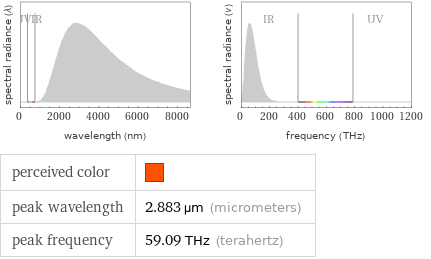Input interpretation

cerium(III) bromide heptahydrate | freezing point
Result

732 °C (degrees Celsius)
Unit conversions

1005 K (kelvins)

1350 °F (degrees Fahrenheit)

1809 °R (degrees Rankine)

585.6 °Ré (degrees Réaumur)

391.8 °Rø (degrees Rømer)
Comparisons as temperature

164.9 °C below large log fire temperature (1170 K)

71.68 °C above melting point of aluminum (660.32 °C)

249.8 °C above typical temperature of an electric oven during self-cleaning (900 °F)
Blackbody information

perceived color | peak wavelength | 2.883 µm (micrometers) peak frequency | 59.09 THz (terahertz)
Corresponding quantities

Thermodynamic energy E from E = kT: | 87 meV (millielectronvolts)

Blackbody energy flux Φ from Φ = σT^4: | 57881 W/m^2 (watts per square meter)

Approximate luminous exitance from a planar blackbody radiator perpendicular to its surface: | 9.5 lx (lux)